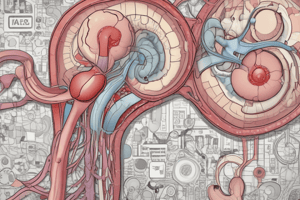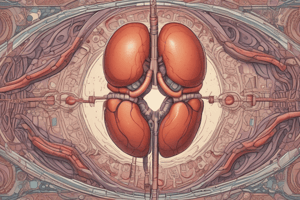Podcast
Questions and Answers
In ESKD, erythropoietin production increases resulting in fatigue, angina, and shortness of breath.
In ESKD, erythropoietin production increases resulting in fatigue, angina, and shortness of breath.
False (B)
Serum calcium and phosphate levels have a direct relationship in the body.
Serum calcium and phosphate levels have a direct relationship in the body.
False (B)
Kidney disease can lead to the increased secretion of parathormone from the adrenal glands.
Kidney disease can lead to the increased secretion of parathormone from the adrenal glands.
False (B)
Uremic bone disease develops due to the imbalance in calcium, phosphate, and parathormone levels.
Uremic bone disease develops due to the imbalance in calcium, phosphate, and parathormone levels.
Calcification of blood vessels is not observed in patients with kidney disease.
Calcification of blood vessels is not observed in patients with kidney disease.
Patients with kidney diseases may retain sodium and water, potentially leading to edema, heart failure, and hypertension.
Patients with kidney diseases may retain sodium and water, potentially leading to edema, heart failure, and hypertension.
Vomiting and diarrhea can lead to water depletion which may worsen the uremic state.
Vomiting and diarrhea can lead to water depletion which may worsen the uremic state.
Metabolic acidosis occurs in End-Stage Kidney Disease (ESKD) due to the kidneys' inability to excrete increased loads of acid.
Metabolic acidosis occurs in End-Stage Kidney Disease (ESKD) due to the kidneys' inability to excrete increased loads of acid.
Anemia in kidney disease patients may develop due to inadequate production of erythropoietin.
Anemia in kidney disease patients may develop due to inadequate production of erythropoietin.
Calcification of blood vessels is a common result of increased parathormone secretion in kidney diseases.
Calcification of blood vessels is a common result of increased parathormone secretion in kidney diseases.
Serum creatinine is a better indicator of renal function than BUN.
Serum creatinine is a better indicator of renal function than BUN.
ESKD patients may experience peripheral neuropathy, especially if they have diabetes.
ESKD patients may experience peripheral neuropathy, especially if they have diabetes.
Renal osteodystrophy is a common manifestation in patients with ESKD.
Renal osteodystrophy is a common manifestation in patients with ESKD.
Calcification of blood vessels is a potential issue for patients with ESKD.
Calcification of blood vessels is a potential issue for patients with ESKD.
Parathormone secretion is typically reduced in patients with ESKD.
Parathormone secretion is typically reduced in patients with ESKD.
What is the consequence of decreased erythropoietin production in ESKD?
What is the consequence of decreased erythropoietin production in ESKD?
How does kidney disease impact the calcium and phosphorus levels in the body?
How does kidney disease impact the calcium and phosphorus levels in the body?
Which hormone is affected by the decreased serum calcium level in ESKD?
Which hormone is affected by the decreased serum calcium level in ESKD?
What contributes to the development of uremic bone disease in ESKD patients?
What contributes to the development of uremic bone disease in ESKD patients?
Which statement accurately describes the metabolic acidosis in ESKD?
Which statement accurately describes the metabolic acidosis in ESKD?
What is a common cause of metabolic acidosis in End-Stage Kidney Disease (ESKD)?
What is a common cause of metabolic acidosis in End-Stage Kidney Disease (ESKD)?
What is one of the factors that contributes to anemia in patients with kidney disease?
What is one of the factors that contributes to anemia in patients with kidney disease?
How do kidneys contribute to calcium imbalance in patients with ESKD?
How do kidneys contribute to calcium imbalance in patients with ESKD?
Which of the following best describes the role of erythropoietin in patients with kidney disease?
Which of the following best describes the role of erythropoietin in patients with kidney disease?
How does phosphorus imbalance occur in patients with ESKD?
How does phosphorus imbalance occur in patients with ESKD?
In End-Stage Kidney Disease (ESKD), which of the following conditions is a common manifestation due to the imbalance in calcium, phosphate, and parathormone levels?
In End-Stage Kidney Disease (ESKD), which of the following conditions is a common manifestation due to the imbalance in calcium, phosphate, and parathormone levels?
The development of anemia in kidney disease patients is primarily due to:
The development of anemia in kidney disease patients is primarily due to:
Which of the following factors results in metabolic acidosis in End-Stage Kidney Disease (ESKD)?
Which of the following factors results in metabolic acidosis in End-Stage Kidney Disease (ESKD)?
Which of the following conditions can worsen the uremic state in patients with kidney disease?
Which of the following conditions can worsen the uremic state in patients with kidney disease?
In ESKD, what effect does increased erythropoietin production have on the body?
In ESKD, what effect does increased erythropoietin production have on the body?
Flashcards are hidden until you start studying




